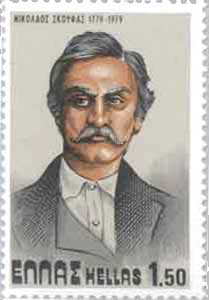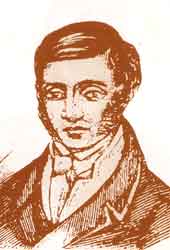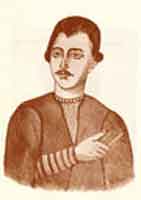.
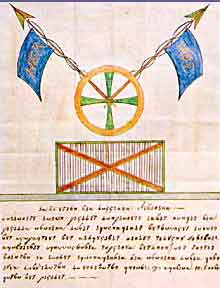
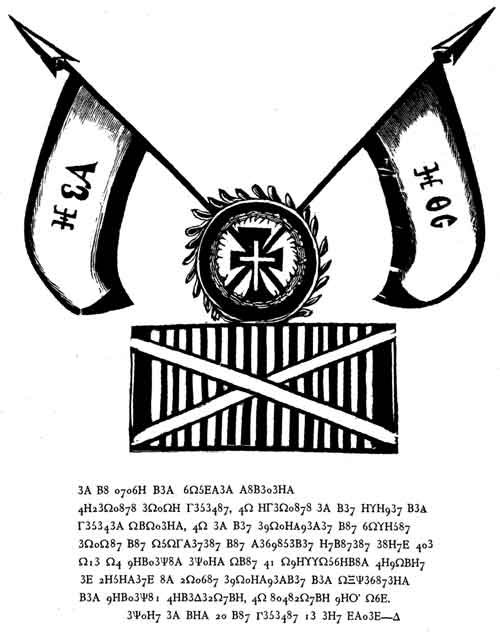
Symbol of the Filiki Eteria
The Filiki Eteria (spelt also Philikí Etaireía), meaning Friendly Society in Greek, was a secret organisation working in the early 19th century, whose purpose was to overthrow the Ottoman rule over Greece and to establish an independent Greek state.
Eteria members were mainly young Greeks from Russia. Eteria received political and material support from Tsar Alexander I, who had an interest in extending Russian influence in the Balkans.
One of the leaders of the Eteria was Alexander Ypsilanti.
The beginnings
|
Athanasios Tsakalov |
Emmanuel Xanthos |
In the context of ardent desire for independence of Turkish occupation and with the explicit influence of secret societies from Europe, three Greeks met one another in 1814 in Odessa and decided the constitution of a strictly secret organisation which would prepare the revolution of all Greeks. These men were 42-years old Nikolaos Skoufas from Arta province, 42-years old Emmanuel Xanthos from Patmos and 26-years old Athanasios Tsakalov from Epirus. Skoufas had already particular contacts with Konstantinos Rados who was initiated into Carbonarism. Ksanthos was initianted in a Free-Masonic Lodge of Lefkada (Society of Free Builders, of St. Mavra), while Tsakalov was a founding member of the "Greek-speaking Hotel", (Ελληνόγλωσσο Ξενοδοχείο or Ellinoglwsso Xenodoxeio) a former but not successful society for the liberation of Greece.
The growth of the Friendly Society is impressive. At the beginning during the 1814-1816 period, there were roughly twenty members. During 1817, the Society developed mainly between the Greeks of Russia and of Moldowallachia (Moldavia and Wallachia), but once again its membership does not exceed thirty. They started doing massive initiations in 1818. In 1820 the Society expanded in almost all regions of Greece and most Greek communities abroad. By the first months of 1821, the membership numbered around one thousand and the Society had exceeded her own limits. Among her members there were tradesmen, clergy, executives of Ottoman Empire from Fanari, chieftains as Theodoros Kolokotronis, Odysseas Androutsos, the metropolite of Old Patrases German and more.

The organisational structure
The whole structure of Philiki Etaireia was imitating the organisational models of Carbonarism and Freemasonry. The leading team was called the "Invisible Authority" and was surrounded at the first moment with such secret glamour that everybody believed that a lot of important personalities participated, not only Greeks but foreigners like Russian czar Alexander I. The reality was that during the start, the Invisible Authority was only the three founders. Then, from 1815 until 1818, five more were added and after Skoufas' death three more were added. In 1818 the Invisible Authority was renamed to "Authority of Twelve Apostles" and each Apostle shouldered the responsibility of a big region.
The whole structure was pyramid-like formed and in the top dominated the "Invisible Authority". No one knew it or had the right to ask who created it. Her commands were executed unquestioned, and members did not have right to make decisions. The society was called «Temple» and it had four levels of initiation: a) brothers or vlamides, b) the recommended, γ) the priests and d) the shepherds. The Priests were charged with the duty of initiation in the first two levels. When the Priest approached somebody, it was first to made sure of his patriotism and catechized him in the aims of society; the last stage was to put him under oath.
Afterwards the initiated were considered neophyte members of the society, with all the rights and obligations of his rank. The Priest immediately had the obligation to reveal all the marks of recognition between the Vlamides or Brothers. Vlamides and Recommended ignored the revolutionary aims of the organisation. They only knew that there existed a society that tried hard for the general good of the nation, which included in its ranks important personalities. This myth was propagated deliberately, in order to stimulate the morale of members and also to make proselytism easier.
The course to the revolt
In 1818, the seat of Philiki Etaireia had migrated from Odessa to Istambul, and Skoufas' death had been a serious loss. The rest of the founders attempted to find a major personality to undertake the reins, one who would give prestige and and fresh impetus to the Society. In the beginning of 1818, they had a meeting with the J. Kapodistrias, who not only denied, but later wrote that he considered Philiki Etaireia guilty for the havoc that was foreboded in Greece. Finally, after many contacts, in April 1820 Alexander Ypsilantis undertook the leadership of Philiki Etaireia.
Recommended Reading
- Vournas Tasos, Friendly Society: her illegal organisational and persecution by the foreigners, Tolides Bros, (Athens 1982).
- Metropolite of Old Patrases Germanos, Memoirs, (Introdutory note, index, ref. Ioanna Yiannaropoulos – Tassos Gritsopoulos), (Athens 1975).
- Yiannis Kordatos, Rigas Feraios and Balkan Federation, (Athens, 1974)
- Xanthos Em., Memoirs for the Friendly Society, (facsimile reprint of 1834 ed), Vergina, (Athens 1996)
| Ancient Greece
Science, Technology , Medicine , Warfare, , Biographies , Life , Cities/Places/Maps , Arts , Literature , Philosophy ,Olympics, Mythology , History , Images Medieval Greece / Byzantine Empire Science, Technology, Arts, , Warfare , Literature, Biographies, Icons, History Modern Greece Cities, Islands, Regions, Fauna/Flora ,Biographies , History , Warfare, Science/Technology, Literature, Music , Arts , Film/Actors , Sport , Fashion --- |
Retrieved from "http://en.wikipedia.org/"
All text is available under the terms of the GNU Free Documentation License

